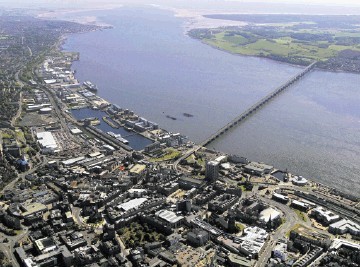
A new multi-million pound investment in the Port of Dundee will prepare the city as the North Sea’s decomissioning hub its owners have said.
Owner Fort Ports is planning to build a new £10million quayside as part of the largest investment in the port’s history.
The new quayside will include industry-leading “heavy lift” capability, coupled with a significant onshore operational area.
Forth Ports said it will position the Port of Dundee at the forefront of the North Sea oil & gas decommissioning and offshore wind sectors.
The privately funded investment will result in the development of the quayside at the East end of the port, connecting to the existing Prince Charles Wharf.
The quayside will offer heavy lift capability over its entire 200m length with an ultra-heavy lift pad at one end. This capability, a deep water berth and a 60-acre land area will enable Dunde to handle the large cargoes likely to be generated as the North Sea’s ageing infrastructure is brought ashore in coming years.
Forth Ports chief executive Charles Hammond, said: “This is an important, privately funded investment for the Port of Dundee which is ideally placed to service the needs of North Sea oil & gas, decommissioning and Scotland’s offshore wind sector over the coming years.
“The port’s existing skills base and location, combined with its riverside berths, deep water and rock river bed, put the port in a key position to become a hub for these sectors for construction, operations and maintenance and for decommissioning.”
Scottish Energy Minister Fergus Ewing said: “Scotland can play a leading role in the development of the decommissioning market and we will continue to work with partners such as Decom North Sea, the Oil and Gas Authority and operators to secure opportunities for the supply chain.”
Ewing added: “While infrastructure such as this will equip Scotland for any decommissioning opportunities that will emerge, our first aim must be to avoid premature cessation of production in the North Sea. While some decommissioning activity is to be expected over the next decade, there are still substantial reserves to be recovered in the North Sea. As someone in the industry put it to me the other week; the industry can have a second wind.”
The construction process in Dundee will take 18 months to complete with work starting immediately. Upon completion, the quayside will be 200 metres longer than currently and will be one of the strongest quaysides in Scotland, at a strength capability of 80 tonnes per square metre.
Hammond added: “Our investment also puts Dundee in a position to benefit from offshore renewable projects such as Neart na Gaoithe* which has the potential to deliver cost efficient renewable energy and economic benefits for Dundee.
“We are committed to investing in the port to ensure the infrastructure is in place to support these industries and for the city of Dundee to fully capitalise on the significant opportunities they present.”
The quayside will effectively add both berthing and land capacity at the Port of Dundee and, once complete, will represent a significant increase in port capacity.
The strengthened quayside will be equipped to handle marine projects such as offshore anchor and chain servicing, which require a strong quayside, and offshore wind turbine assembly and deployment activities, as well as operations and maintenance.
Last week Aberdeen Central MSP Kevin Stewart, SNP, said: “It makes absolutely no sense whatsoever to base an oil and gas centre anywhere other than Aberdeen, where the expertise lies.”
North-east MSP Alex Johnstone, Conservative, said: “The last thing we want to see is opportunities being taken out of the Aberdeen economy at this time to benefit Dundee.”
Business at the Port of Dundee has grown in the past 12 months, with the port attracting a new general cargo tenant, as well handling and drying a record 60,000 tonnes of barley during harvest 2015.
Recommended for you
